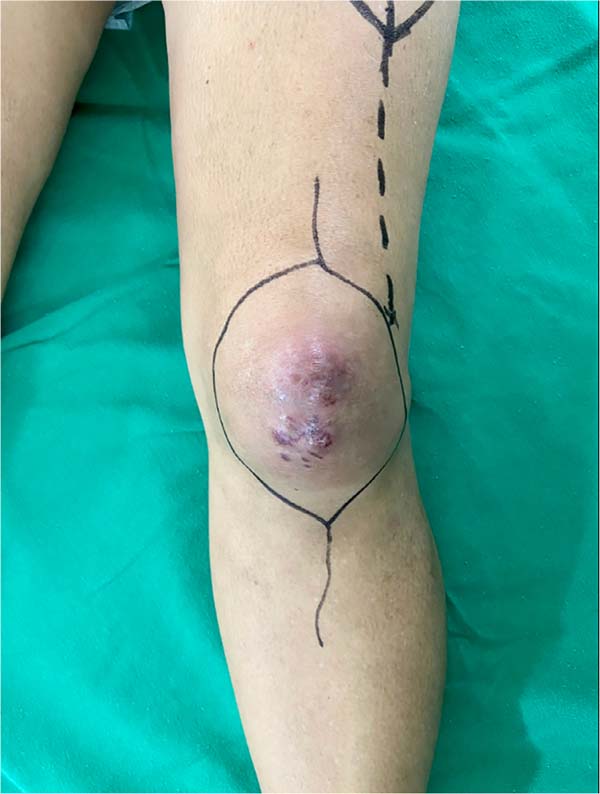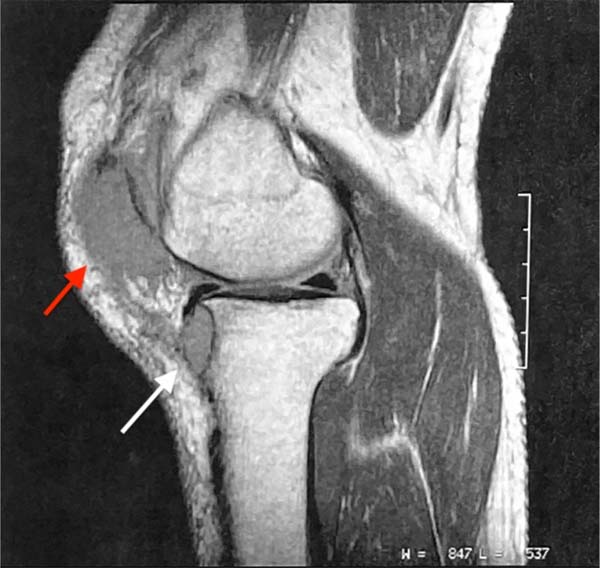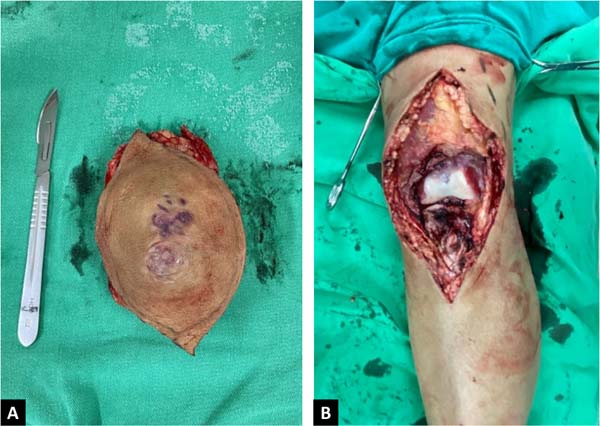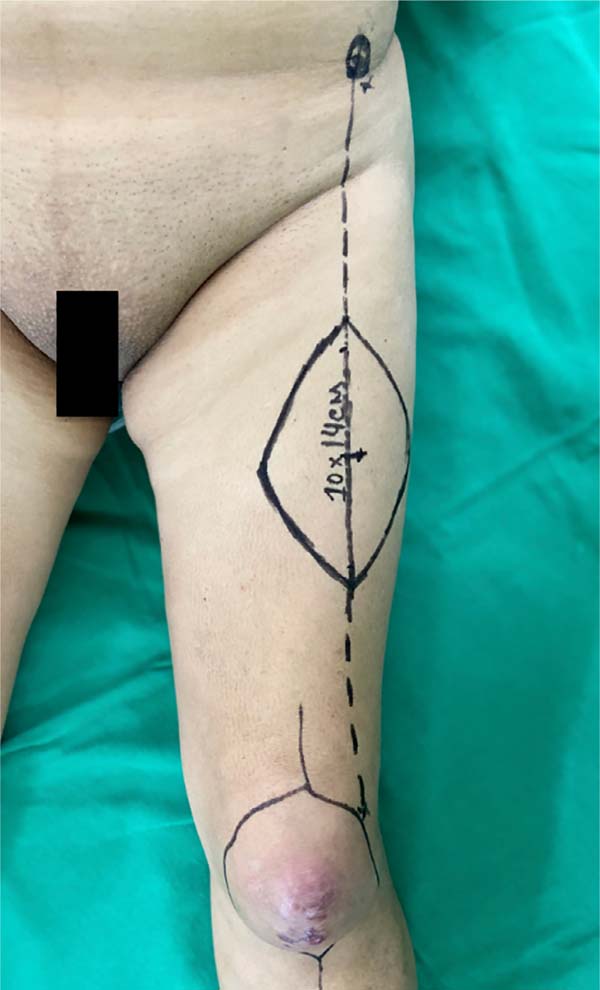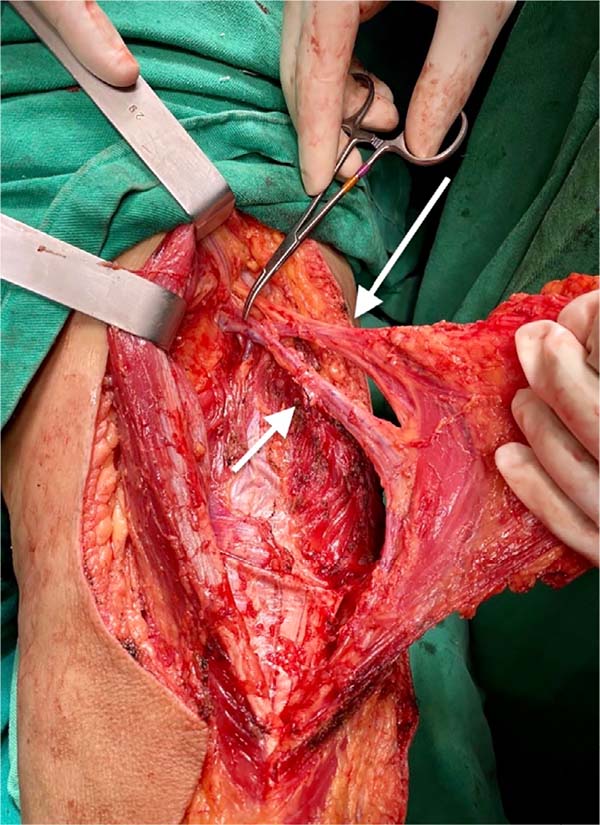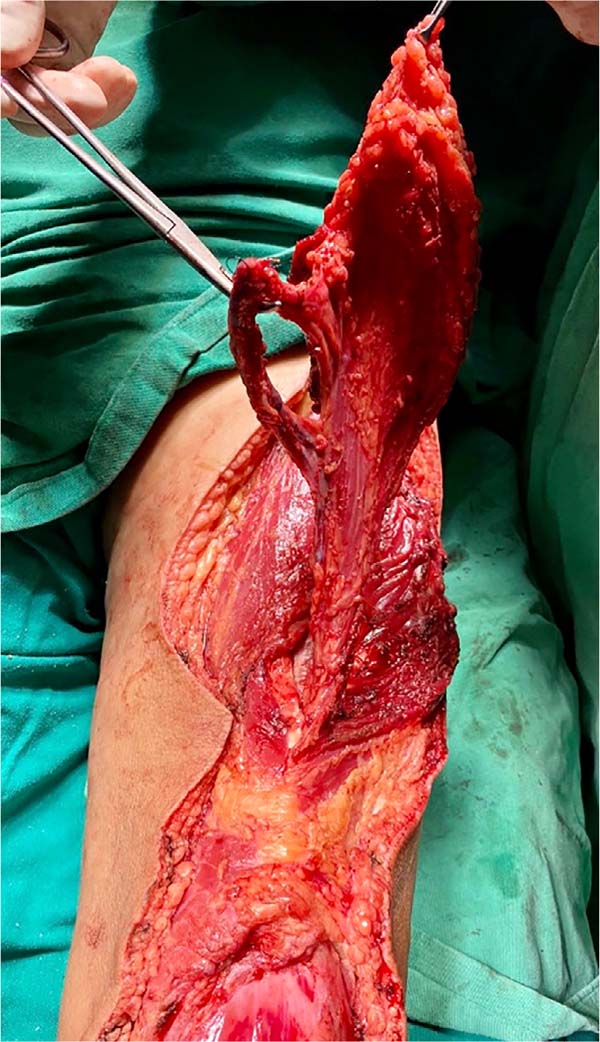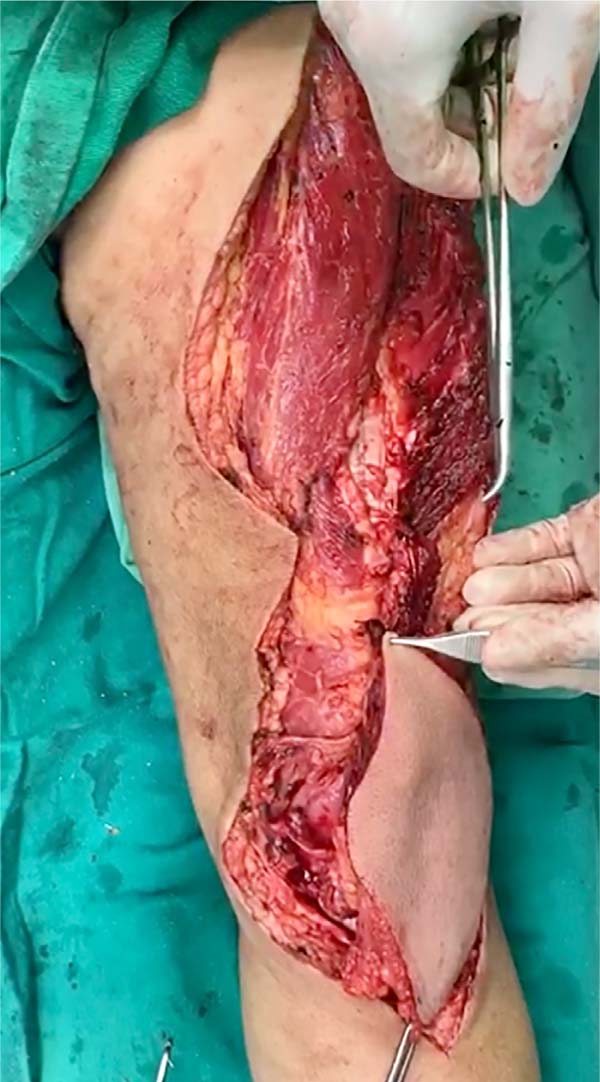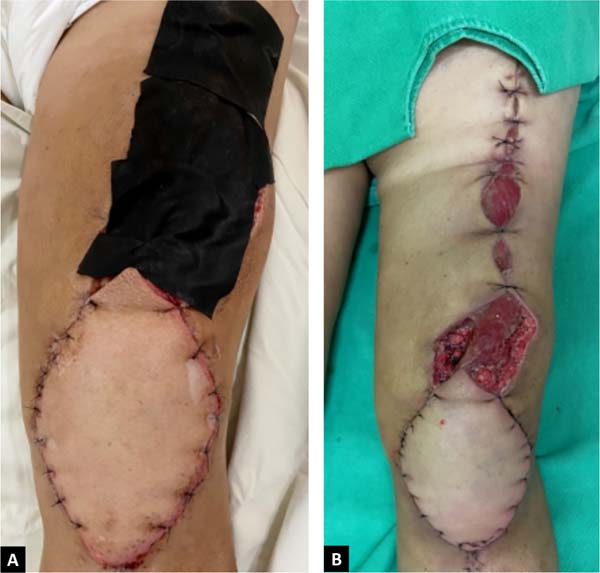INTRODUCTION
Soft tissue reconstruction of the knee and the areas adjacent to it has always
been a challenging procedure. In addition to post-traumatic defects, soft tissue
defects in the knee area can be caused by chronic infections, actinic lesions,
or surgeries for lysis of the wounds due to burns1. The knee joint is a hinge type, mainly
performing flexion and extension movements of the leg and with minimal
rotation2.
Reconstruction is a challenge for surgeons, having seen the need for flaps to be
effective not only for coverage but also for thin enough not to impair mobility
after recovery2.
Sometimes these injuries are caused by resections of bone tumors in the distal
femur, patella, and proximal tibia. The patella is an uncommon site for the
appearance of bone tumors, benign or malignant, and pseudotumoral lesions. In
the literature, there is a small amount of work on this topic3. Most tumors are benign, with a
significant incidence of giant cell tumors and chondroblastomas4. The most frequent malignant
tumor is hemangioendothelioma, followed by lymphoma and osteosarcoma3.
This case report is about a patient with a metastatic tumor in the patella and
reconstruction of the deformity with an anterolateral reverse flow thigh flap.
In the literature, there are reports of giving up surgical planning when the
main perforator of the flap does not originate from the descending branch of the
lateral circumflex femoral artery (LCFA)5. However, this work aims to show that, given this
anatomical change, the making of the flap does not necessarily need to be
discarded.
OBJECTIVE
General
Show and discuss lower limb reconstruction based on an anterolateral reverse
flow thigh flap with acceptable aesthetic results for skin coverage in the
anterior region of the knee.
Ethical aspects
The present case report follows the declaration of Helsinki. The patient was
given an informed consent form (ICF). The patient was consulted about using
her clinical data from medical records and photographs of the surgical
procedure to prepare this case report.
CASE REPORT
The case comes from the Pernambuco Cancer Hospital (HCP). Patient JFS, 39
years old, female, brown, rural worker, born in and coming from Calumbi/PE,
presented an expansive formation, measuring 5.2x3.3 cm, located in the
patellar region of the left knee (Figure 1). She showed clinical pain, local edema and limited limb
flexion. The onset of symptoms in May 2019. As a background, she reported
right nephrectomy in 2015 due to a renal tumor and histopathological
examination compatible with clear cell carcinoma.
Figure 1 - Macroscopic view of the tumor.
Figure 1 - Macroscopic view of the tumor.
The first diagnostic hypothesis raised by the orthopedics team was the
possibility that it was a benign soft tissue tumor, probably a
chondroblastoma. However, magnetic resonance imaging of the left knee showed
solid expansive formation in the left patella, predominantly in its
centromedial region, measuring 5.2x3.3x2.9 cm, with discontinuity of the
bone cortical and soft tissue component. In addition, an expansive formation
with the same characteristics was also noted on the anterior margin of the
medial tibial plateau, measuring 1.9x0.6cm (Figure 2).
Surgical planning performed in conjunction with plastic surgery included
total resection of the patella in a bloc with the soft parts of the anterior
region of the knee and curettage of the tibial plateau region. The plastic
surgery initially planned reconstruction with a medial gastrocnemius flap,
in case it was a small to moderate defect, and anterolateral reverse flow
thigh flap or free flap in the case of a large size. However, no imaging
study was carried out to evaluate vascular irrigation of the knee or the
distal region of the thigh before surgery.
The plastic surgery team consisted of a plastic surgeon specializing in
microsurgery, a resident in the last year of plastic surgery, and another in
the second year. There was a possibility of microsurgical reconstruction;
therefore, the microscope was on stand-by in the operating room; however, it
was not used for reconstruction.
Figure 2 - Sagittal nuclear magnetic resonance image of the left knee with a
tumor in the patella (red arrow) and medial tibial plateau (white
arrow).
Figure 2 - Sagittal nuclear magnetic resonance image of the left knee with a
tumor in the patella (red arrow) and medial tibial plateau (white
arrow).
The orthopedics team operated on the patient with bone and soft tissue
resection involving the regions of the patella and the distal medial
fragment of the tibia (Figure 3). The
reconstruction proposed by the plastic surgery team was an anterolateral
reverse flow thigh flap measuring 14x10cm (Figure 4). In the perioperative period, it was observed that it
was a type II flap since the main perforator of the flap did not originate
from the descending branch but from the transverse branch of the
LCFA5. This finding
required that the dissection reach the LCFA trunk to include the main
cutaneous perforator in the flap (Figure 5). Clamping was performed above the bifurcation of the
descending and transverse branches with a 6cm bulldog vascular clamp to test
for reverse flow patency. After certification of the flap vascularization
through reverse flow, double ligation of the vessels was performed with 3-0
cotton thread and flap rotation (Figures 6 and 7). The donor area
was partially closed, with an approximation of the edges using a 3-0 nylon
thread and healing by third intention and subsequent skin grafting. A muscle
layer protected the pedicle from the rectus femoris along its entire length.
The procedure was performed under spinal anesthesia for a total of 2.5 hours
(Figure 8) with an acceptable
esthetic result (Figure 8 - B).
Protection was performed in the donor area with a silver foam dressing.
Immobilization was performed with a plaster splint to prevent knee flexion.
The primary dressing was changed daily. The patient was instructed not to
walk in the first 72 hours and underwent deep vein thrombosis prophylaxis
with 40mg of enoxaparin. After the first 72 hours, we advise walking with a
full-length limb and protection with a plastered splint. The patient was
discharged on the seventh day after surgery, with no complications during
this period.
Figure 3 - A. Resected surgical specimen; B.
Result after approaching orthopedic surgery with resection of the
patella, soft tissue and tibial fragment.
Figure 3 - A. Resected surgical specimen; B.
Result after approaching orthopedic surgery with resection of the
patella, soft tissue and tibial fragment.
Figure 4 - Planning of the anterolateral thigh flap.
Figure 4 - Planning of the anterolateral thigh flap.
The pathology results coincided with that of the previous biopsy, resulting
in clear cell carcinoma.
Figure 5 - Dissection of the main perforating branch of the flap (larger
arrow) originating from the transverse branch and not from the
descending branch (smaller arrow) of the LCFA.
Figure 5 - Dissection of the main perforating branch of the flap (larger
arrow) originating from the transverse branch and not from the
descending branch (smaller arrow) of the LCFA.
The patient returned to the outpatient clinic on the fifteenth and thirtieth
day after surgery, showing satisfaction with the esthetic result. She also
had a slight flexion of the knee. However, having performed resection of the
patella and the entire knee stabilizing mechanism evolved with joint
instability. Finally, however, she was able to walk with the aid of
auxiliary walking devices.
DISCUSSION
Skin and soft tissue reconstruction in the region around the knee are often
challenging for the plastic surgeon and aim to cover the exposed bone,
preserving the joint function of the knee and providing a good esthetic result.
There is an option for the use of free flaps, where there is a need for adequate
material and trained staff. However, the vascular anastomosis region at the back
of the knee makes the procedure even more complex. The reverse anterolateral
fasciocutaneous flap of the thigh, first described in 1990 by Zhang et
al.6, seems to be an
effective and reliable option in the reconstruction of defects around the knee,
given that it has a long vascular pedicle length and availability of soft
parts7,8. The vascular base of this flap is the
anastomosis between the descending branch of the LCFA and the lateral superior
genicular artery (LSGA), which is located about 3 to 10 cm above the lateral
edge of the patella. This connection maintains constant skin perfusion through
retrograde blood flow, sufficient for the flap’s survival5. However, there are some
anatomical variations in which the cutaneous perforator does not originate from
the descending branch2.
Figure 6 - Elevation of the flap and pedicle after the proximal section of the
vessel.
Figure 6 - Elevation of the flap and pedicle after the proximal section of the
vessel.
In the literature, there are reports of giving up surgical planning when the main
perforator of the flap does not originate from the descending branch of the
LCFA5. In the case
reported here, the planning was maintained, considering the good perfusion after
clamping, above the bifurcation, between the descending and transverse branches.
Some points should be considered for a good outcome: the non-compression and
maintenance of a muscle layer around the pedicle and the confirmation of flow
with vascular clamping.
CONCLUSION
Based on the perforator in the transverse branch of the LCFA, the reverse flow
anterolateral thigh flap proved to be a good option, fast and with an acceptable
aesthetic result for skin coverage in the anterior region of the knee.
Figure 7 - Flap in final position.
Figure 7 - Flap in final position.
Figure 8 - A. 72h postoperatively (left); B. 15 days
postoperatively.
Figure 8 - A. 72h postoperatively (left); B. 15 days
postoperatively.
REFERENCES
1. Gravvanis A, Kyriakopoulos A, Kateros K, Tsoutsos D. Flap
reconstruction of the knee: a review of current concepts and a proposed
algorithm. World J Orthop. 2014 Nov;5(5):603-13.
2. Song M, Zhang Z, Wu Y, Ma K, Lu M. Primary tumors of the patella.
World J Surg Onc. 2015 Abr;13:163.
3. Bapista AM, Sargentini SC, Zumárraga JP, Camargo AF, Camargo
OP. Tumores da patela: a experiência do instituto de ortopedia e
traumatologia da Universidade de São Paulo. Acta Ortopéd Bras.
2016;24(3):151-4.
4. Bharathi RR, Ramkumar S, Venkatramani H. Soft tissue coverage for
defects around the knee joint. Indian J Plast Surg. 2019
Jan;52(1):125-33.
5. Demirseren ME, Efendioglu K, Demiralp CO, Kilicarslan K, Akkaya H.
Clinical experience with a reverse-flow anterolateral thigh perforator flap for
the reconstruction of soft-tissue defects of the knee and proximal lower leg. J
Plast Reconstr Aesthet Surg. 2011 Dez;64(12):1613-20.
6. Zhang G, et al. Reversed anterolateral thigh island flap and
myocutaneous flap transplantation. Zhonghua Yi Xue Za Zhi. 1990
Dez;70(2):676-8.
7. Guataçara Junior SS, Freitas RS, Novais JR, Maschio AG, Paula
DR, Marcante RFR, et al. Retalho anterolateral da coxa reverso: uma
opção de reconstrução para os membros inferiores.
Rev Bras Cir Plást. 2018;33(4):493-500.
8. Pan SC, Yu JC, Shieh SJ, Lee JW, Huang BM, Chiu HY. Distally based
anterolateral thigh flap: an anatomic and clinical study. Plast Reconstr Surg.
2004 Dez;114(7):1768-75.
1. Hospital das Clínicas, Federal
University of Pernambuco, Recife, PE, Brazil.
2. Pernambuco Cancer Hospital, Recife, PE,
Brazil.
Corresponding author: Fábio Santiago
de Macedo, Rua Hermogenes de Morais, 252, Apt 2901 - Madalena, Recife
- PE, Brasil, Zip Code 50610-160, E-mail:
fsdemacedo@gmail.com
Article received: June 08, 2020.
Article accepted: April 23, 2021.
Conflicts of interest: none.
Institution: Pernambuco Cancer Hospital, Recife, PE, Brazil.



